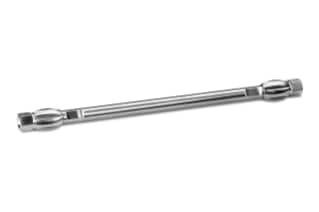
|
Chemistry |
Phenyl |
|
Separation Mode |
Reversed Phase |
|
Particle Substrate |
Hybrid |
|
pH Range Min |
1 pH |
|
pH Range Max |
12 pH |
|
Maximum Pressure |
6000 psi (415 Bar) |
|
Endcapped |
Yes |
|
Bonding Technology |
2-methyl-2-phenylethyl |
|
Silanol Activity |
Low |
|
Particle Shape |
Spherical |
|
Particle Size |
3.5 µm |
|
Endfitting Type |
Waters |
|
Pore Size |
125 Å |
|
Format |
Column |
|
Surface Area |
175 |
|
System |
HPLC |
|
USP Classification |
L11 |
|
Inner Diameter |
3.9 mm |
|
Length |
150 mm |
|
Carbon Load |
12 % |
|
UNSPSC |
41115709 |
|
Brand |
XTerra |
|
Product Type |
Columns |
|
Units per Package |
1 pk |

XTerra Phenyl Column, 125 Å, 3.5 µm, 3.9 mm x 150 mm, 1/pk
The XTerra Phenyl Column is a hybrid-based, reversed-phase column with phenyl ligand functionality that should be included in your lab equipment collection. When compared to a silica-based column, these first-generation Xterra columns exhibit improved pH stability.
The XTerra Phenyl Column is an important piece of laboratory equipment that can provide complementary selectivity to straight-chain alkyl stationary phases, particularly for molecules containing aromatic rings. It also has superb peak shape for all chemicals and extremely reproducible retention durations, as well as strong pH stability and great surface coverage. This is achievable because of the potent combination of Hybrid Particle Technology and the Xterra phenyl chemistry, which results in a unique stationary phase capable of providing these exceptional properties. Furthermore, the difunctional bonding chemistry of the short-chain phenyl ligand in the XTerra Phenyl Column improves the column's low pH hydrolytic stability. This one-of-a-kind substrate and ligand give a new dimension of selectivity to complex mixture separations.
Waters Hybrid Particle Technology is used to create the packing materials used in the XTerra Phenyl Column. The XTerra particles comprise both inorganic (silica) and organic (organosiloxane) components, so they benefit from the best of both worlds. When compared to Silica-based reversed-phase packing materials, this Hybrid technique enables great separation efficiency and enhanced pH stability. To control the chemical composition and purity of the Hybrid particle, XTerra Columns are manufactured using only ultrapure reagents. Every production process is completed within close tolerances, and each column is independently tested. Each column comes with certificates of Batch Analysis and Column Efficiency.
To satisfy your chromatographic needs, the Xterra Columns are available in a variety of porosity and particle sizes. You may learn more about them in our catalog or on our website, and you can also shop for lab equipment through either media.
You may also be interested in XTerra Phenyl VanGuard Cartridge, 125 Å, 3.5 µm, 3.9 mm x 5 mm, 3/pk; XTerra Phenyl VanGuard Cartridges are used to enhance analytical column lifetime and performance by eliminating particle pollution from the mobile phase stream. This cartridge is designed to protect all 3.9 mm and 4.6 mm I.D. cartridges. 3.5 m sorbent particles in XTerra Phenyl analytical columns.
What Is The Meaning Of Protein Expression?
Protein expression encompasses the processes involved in the production, modification, and regulation of proteins in living organisms. This term can be used to describe either the subject of study or the laboratory methods employed to generate proteins for protein research.